Pete
Lyons' fantastic Can-Am Cars in Detail:
 |
May/June 2014
Reload
to see the latest news
All news content copyright Michael J. Fuller, unless
otherwise noted |
Mulsanne's Corner Book Store
A selection of sports car related DVDs and books, with a technical slant. | | >>Le Mans 2014<< | | 6.17.14
>>Some
more follow up on Toyota Winggate! Toyota are actually utilizing
two seperate version of their automatic air flow modifying low drag
rear wing. If you need a little more background check out the Le Mans 2014 page.
 | The
first version is identifed by the inboard bracket (1) that connects the
main plane to the endplate. The wing mount is silver and features
a round bolt (2). The final feature is the flap bolt hole pattern
(3) is a single row of approximately 8 holes.
This version of the wing aligns with the original description:
The
rear wing mainplane is attached to the central swan neck rear wing
mount through a single mounting point. The secondary flap
attaches to the mainplane via conventional slot gap separator brackets.
Outboard, the mainplane has a single attachment point at the
endplate and the secondary flap also has a single attachment point for
angle changes, as one would expect.
The
outboard ends of the assembly are actually attached to the endplate and
the wing's rotation is limited to the middle section. The
laminate schedule of the wing is designed to facilitate the rotation,
thus the wing actually deforms (though non-uniformly; thus it would
seem to mean the wing, once rotated into its low drag nose up
positions, is no longer a uniform section and in violation of Art 3.6.2
a.2). Ironically Toyota's competitors have dubbed this one as the "more legal" version.
| 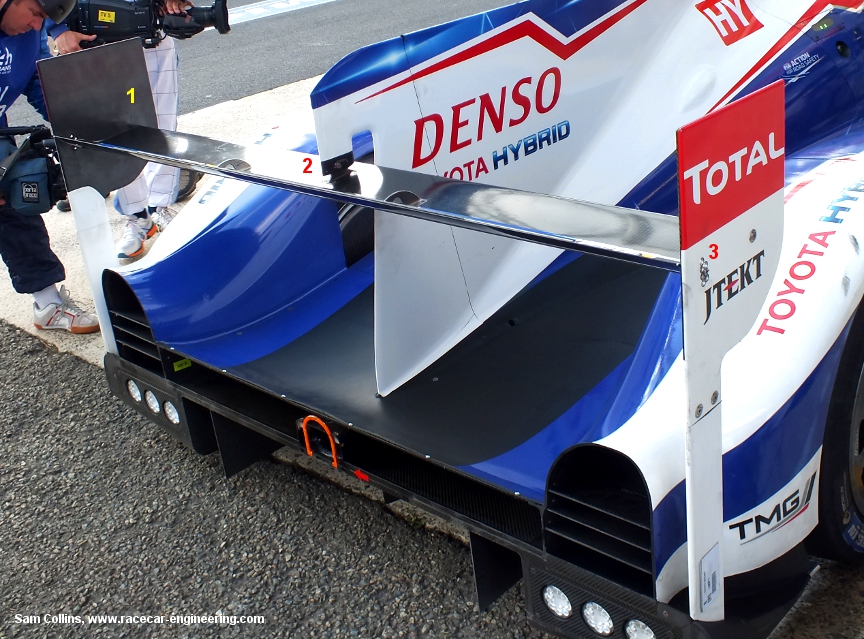 | The second version lacks any brackets inboard of the endplate (1). 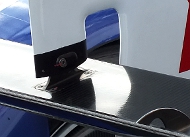 The
wing mount is black (2) and has a raised oval shape in the middle.
Outboard on the endplate, the flap holes (3) are two parallel rows of 3
and 4 bolts. The
wing mount is black (2) and has a raised oval shape in the middle.
Outboard on the endplate, the flap holes (3) are two parallel rows of 3
and 4 bolts.
This version of the wing actually allows the entire
wing assembly to pivot. From a drag reduction standpoint I can
imagine this is the more effective device.
Throughout the race
weekend both assemblies were used on both cars. And it appears
during the race the assembly was changed on the #8 (race day photos
show the #8 running both at various times).
|
| 
| 6.1.14
>>Le Mans coverage will be gearing up, to the extent that I have an photo email bomb from Race Car Engineering's Sam Collins to start sorting through (my LEAST favorite task). However, in the mean time, while looking at the Timing & Scoring data,
my attention was drawn to the #8 Toyota TS040's overall times, sector
times, and trap speeds. Something interesting caught my eye; on
the Toyota's fastest lap (and the fastest lap overall of the Test
Day), 3:23.014 (lap
#9), it went through Sector 2 (the section from 1/5 of the way down the
Mulsanne to Mulsanne Corner) in a 1:17.851 (#8's fastest time through
the sector) but went through the speed traps at only 297.2 km/h.
The speed trap is set up just before the first chicane as this is
traditionally the fastest section of the track. So thus the speed
trap is smack dab in the middle of Sector 2. However on another
lap, this one decidedly an in-lap (3:39.907, the finish line being
crossed on pit lane), the #8 whipped through the speed traps at 336
km/h, though with a Sector 2 time of 1:19.466. So a full 38 km/h
faster than their banzai lap's top speed through the speed trap and not
quite totally off it from the Sector 2 time comparison. Yes, it
could have been through drafting the #8 achieved 336 km/h.
However, let's not loose focus; 297km/h is paltry for an LMP1!
But surely something's going on here, not the least which is the
obvious; sandbag-o-rama.
Last year's Pole time was a
3:22.346. So without really trying the 2014 cars are within .67
seconds of last year. Suffice to say, last year's Pole will be
shattered in two week's.
| 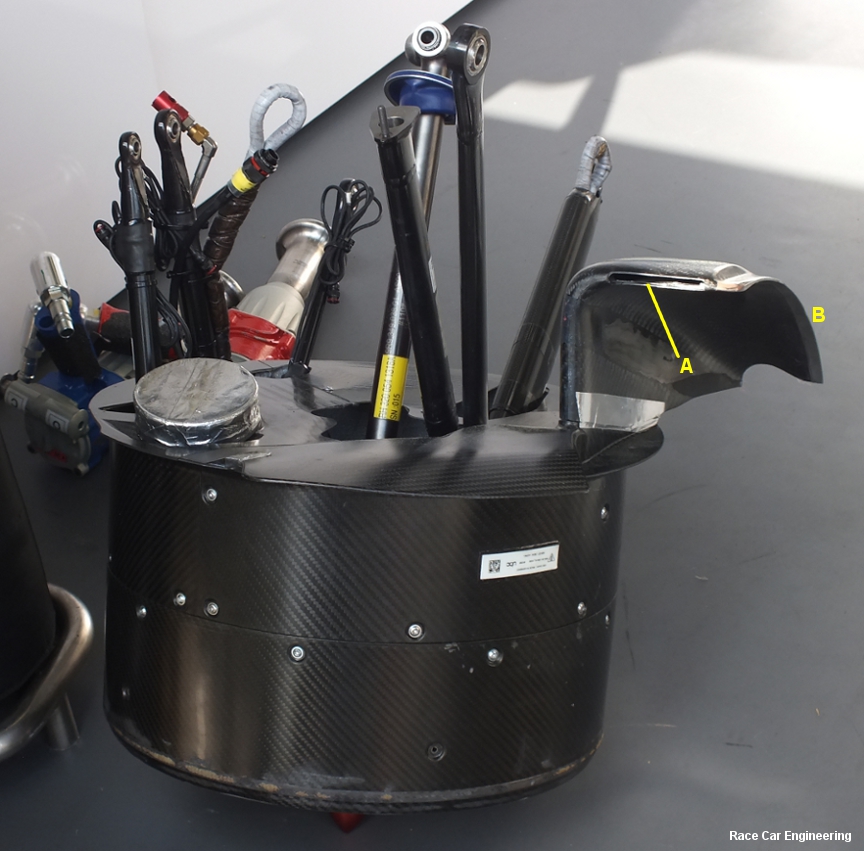 One
of the gems from the Sam's email photo dropbox bomb is this shot from
Spa of the Porsche 919's front right upright/brake drum/front
suspension assembly. Lookie thar...So Porsche has covered their
bases and insured that their strake can be called anything but a strake
inasmuch as clearly it's a brake duct. Note the inlet (A).
And I guess while they were designing a brake duct, you know,
might as well give it some strakage (B). One
of the gems from the Sam's email photo dropbox bomb is this shot from
Spa of the Porsche 919's front right upright/brake drum/front
suspension assembly. Lookie thar...So Porsche has covered their
bases and insured that their strake can be called anything but a strake
inasmuch as clearly it's a brake duct. Note the inlet (A).
And I guess while they were designing a brake duct, you know,
might as well give it some strakage (B). | 
| 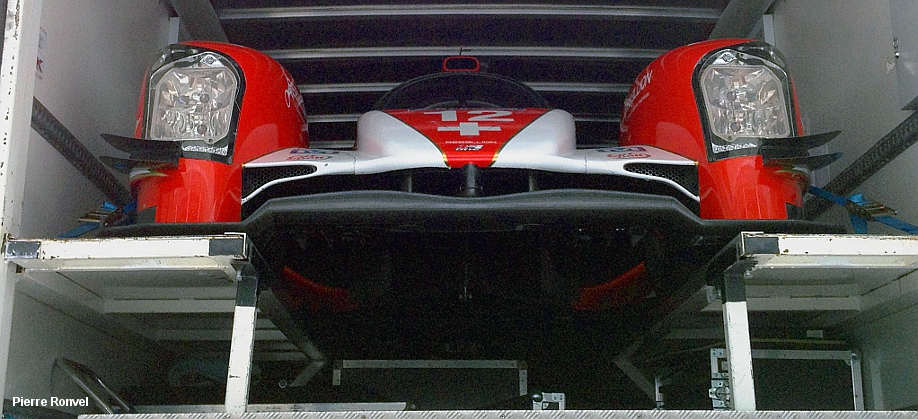 5.27.14 5.27.14
>>As
opportunity presents itself...caught this afternoon in the Le Mans
paddock, the Rebellion R-One reveals a couple of things of interest.
For one, it appears the R-One's livery is more definitive.
At very least it's different than the shots we've seen of the car
testing. Secondly, this seems to be the first look at the car's
diveplanes. In this shot and the one below understand that the
flat floor has been removed. I've altered the contrast a bit in
an attempt to lighten up the dark areas of the front diffuser, hence
the "graining." More of that area below. | 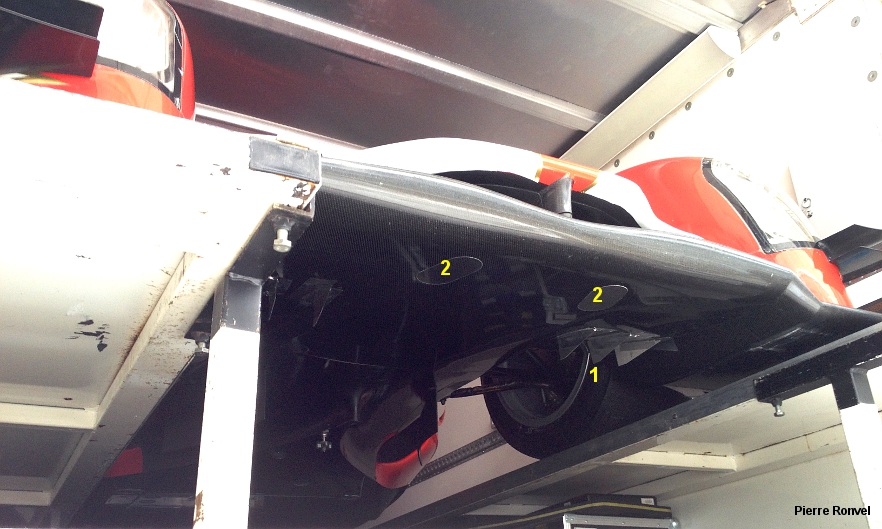 The
set of three aluminum fabricated vortex generators (1) that are
arraigned either side of the centerline are taped in place. This
all suggests continuing development (obviously) and a recent trip to
either a wind tunnel or coast down testing on-track. A question
was asked about the oval-shaped covers (2) that can be seen; my best
guess is that they are access hatches and related to how the
splitter/diffuser attaches to the mounts above. The
set of three aluminum fabricated vortex generators (1) that are
arraigned either side of the centerline are taped in place. This
all suggests continuing development (obviously) and a recent trip to
either a wind tunnel or coast down testing on-track. A question
was asked about the oval-shaped covers (2) that can be seen; my best
guess is that they are access hatches and related to how the
splitter/diffuser attaches to the mounts above.
| |
|

